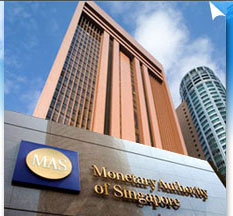
As we seem to be embarking on another round of "currency wars", the Monetary Authority of Singapore (MAS) has communicated after the first of two monetary policy meetings this year, that it will remain committed to a strong Singapore dollar.
Meanwhile, an internal probe by Deutsche Bank has uncovered that there was an inappropriate communication between the bank's director of sales in the London office, Ms Kai Lew, who was responsible for the company's central bank clients before being put on leave, as an internal investigation produced this bit of new FX fixing related information.
Singapore's Unique Monetary Policy Framework
The MAS has quite a unique way to conduct monetary policy and one might say that the foreign exchange market information is crucial to its critical lever - the exchange rate. In contrast to the vast majority of global central banks, the openness of Singapore's economy has pushed monetary authorities to take a different approach. The uniqueness of the country's monetary policy is precisely why communication between Deutsche Bank and MAS is viewed as a very sensitive topic. The central bank can make its job much easier if it has substantial information about the order flow on the Singapore dollar (SGD) foreign exchange market.
The Singapore dollar is managed by the MAS against a currency basket comprised by the country's major trading partners and competitors. The central bank established the weight of every different currency by taking into account the trade flows between the countries and the way the corresponding economy is impacting Singapore's exposure to the rest of the world. Being a massively export dependent economy and a crucial financial and logistics centre, the way monetary policy is conducted has proven to be an essential tool for the booming economy since 1981.
The direction and the intensity of the central bank's effort is announced twice a year in April and October, aiming to determine the policy band of the exchange rate fluctuation and sometimes certain levels that the MAS is aiming to defend or reach. The direct result is a much smoother functioning of the exchange rate, without the central bank sacrificing flexibility.
Half-year Monetary Policy Statement
After this year's first meeting in April, the MAS has announced today in its monetary policy statement that it will continue to support a modest and gradual appreciation of the Singapore dollar against the currency basket. This decision essentially leaves the course of policy unchanged since April of 2012. With the current monetary policy methodology being in place for more than 20 years, the country bodes one of the most successful inflation records, with prices rising about 1.9% per annum for the duration of the monetary policy framework in place.
The central bank's impeccable low inflation record makes the MAS viewed on the currency markets as one of the most hawkish and solid central bank institutions. Its worth noting that over the same period between 1981 and 2014 accompanying the economy's booming growth was a currency that has been largely appreciating to the US dollar, with the notable exception being the period in the aftermath of the Asian banking crisis that erupted in 1997.
The Singapore Dollar - An Insulated Regional Safe Haven
The lack of control by the MAS over key tools used in other countries such as interest rates and money supply, permits Singapore to benefit in a big way from relatively low interest rates which are set by the global markets, while at the same time the local monetary policy authority has not made a single easing effort. Low interest rates coupled with a strong exchange rate have served the country well even throughout the most turbulent times of the global financial markets crisis in the end of the last decade.
While Forex Magnates reporters did not manage to obtain any additional information from the MAS press department, as a comment related to the communication with the Deutsche Bank employee was denied, the involvement of a central bank in the FX fishing scandal makes it the second monetary policy institution after the Bank of England, that directly got involved.
Singapore's exchange rate system has substantially reduced short-term Volatility of the country's real economy, smoothing out the economic cycle and enforcing a stringent mechanism which encourages the Singapore dollar exchange rate to be firmly aligned with economic fundamentals.
While this monetary policy framework is not universally applicable, it has certainly made its way to becoming a great model for some economies, especially in South-East Asia, where managed floats are very widely spread.
The country boasts a unique mix of prudent fiscal policy, flexible product and factor markets, sound financial system, and robust domestic corporate sector. Owing to the firm central bank policy throughout the decades, the Singapore dollar has become somewhat of a regional safe haven in times of crisis.






















